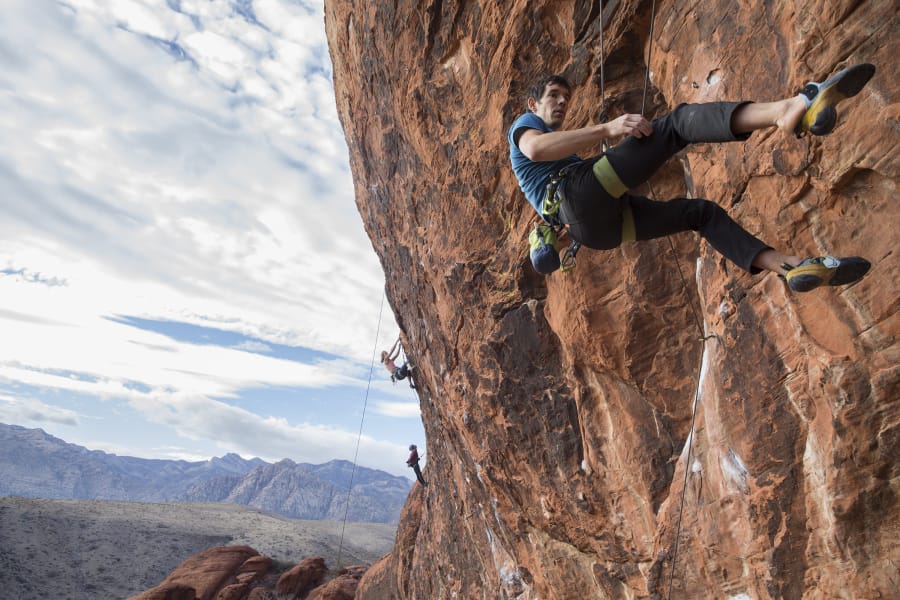Alex Honnold, rock climber of El Capitan fame, at home in Las Vegas
Not long after moving to Las Vegas in early 2017, the man who scales granite walls for a living decided that his new neighbors might deserve a little explanation about his peculiar lifestyle. ■ Especially the two retirement-age women he figured might be home all day, likely keeping a watchful eye out their living room windows. With his oddball hours and stream of visitors, he wanted to make sure they knew he “wasn’t just some crack dealer.” ■ One day, he saw them outside and approached. ■ “Hi, I’m Alex Honnold, your new neighbor,” he began politely. “I’m a professional rock climber.”
 Alex Honnold at The Gallery at Red Rock Canyon on Dec. 17, 2018, in Las Vegas. (Benjamin Hager / Las Vegas Review-Journal)
Alex Honnold at The Gallery at Red Rock Canyon on Dec. 17, 2018, in Las Vegas. (Benjamin Hager / Las Vegas Review-Journal)He explained that there would often be sketchy-looking vans parked outside his house. People would come and go. Packages would be left at the doorstep. None of it was illegal, he said.
But Honnold is not just a professional rock climber. He is arguably the world’s best, having accomplished a feat no other human has mastered.
The nonstop traffic is just one of the trappings that come from being known for audaciously scaling towering faces of vertical granite, sometimes without a net. Those sketchy vans belong to friends, fans and fellow climbers who’ve chosen the so-called “dirt-bag” adventure life, living out of their vans to stay closer to their rock-faced holy grails. And the deliveries weren’t drugs, but merely products from sponsors.
Honnold’s girlfriend, Cassandra “Sanni” McCandless, later delivered Christmas cookies to the pair.
“What’s a professional rock climber?” they suddenly asked.
Oh, they’re just nomads who are sponsored by protein bar companies, she explained. This time, the women laughed: They admitted they’d been suspicious of Honnold, and had even called the community association.
Now, they said, it was actually a thrill to have a celebrity in their midst.
Not just any celebrity, but in the eyes of many, a rock star.
Yosemite’s El Capitan
On June 2, 2017, Honnold became the first person to climb the iconic 3,000-foot El Capitan rock formation in Yosemite National Park without the aid of ropes, gear or human support.
His four-hour ascent was a form of moving meditation, a series of grabbing minuscule ledges and making ice-veined jumps between edges, where one slip would have resulted in a nearly unfathomable 15-second plummet to the valley floor below.
The jaw-dropping feat was chronicled in the 2018 film documentary “Free Solo.”

The accomplishment has propelled Honnold to the peak of elite adventure athletes worldwide. Outside magazine called the exploit “the moon landing of free-soloing … a generation-defining climb. Badass and beyond words.”
National Geographic praised the effort as “the greatest feat of pure rock climbing in the history of the sport,” and The New York Times characterized it as “one of the great athletic feats of any kind, ever.”
Such high-altitude praise seems lost on Honnold, a 33-year-old Sacramento, California, native who lived out of his 2002 Ford Econoline van for years before graduating to a newer, more tricked-out 2016 Dodge Ram ProMaster van and finally settling in Las Vegas full time about two years ago.
He shrugs at the accolades.
“I guess you just assume they’re all wrong,” he said.
Such humility is classic for the climber known as Alex “No Big Deal” Honnold. Lanky at 5-foot-11 and 156 pounds, with large brown eyes and a low-wattage, almost 1960s flower child sense of chill, he’s an athlete whose resting heart rate must hover near the flat line.
In “Free Solo,” one climber refers to Honnold as “Spock,” a moniker Honnold attributes to his “boring” and “understated” nature, a “hyper-rationality” that dismisses his death-defying feats as all too human.
Falling for Las Vegas
Still, there are a few subjects that light his enthusiasm: the wonder of rock climbing, for starters, and, more improbably, living in Las Vegas.
“People ask me all the time, especially in Europe, ‘So, why Vegas?’ And I’ll tell them, that for a rock climber, Las Vegas is like the coolest place on the planet. You can go climbing here every day of the year.”
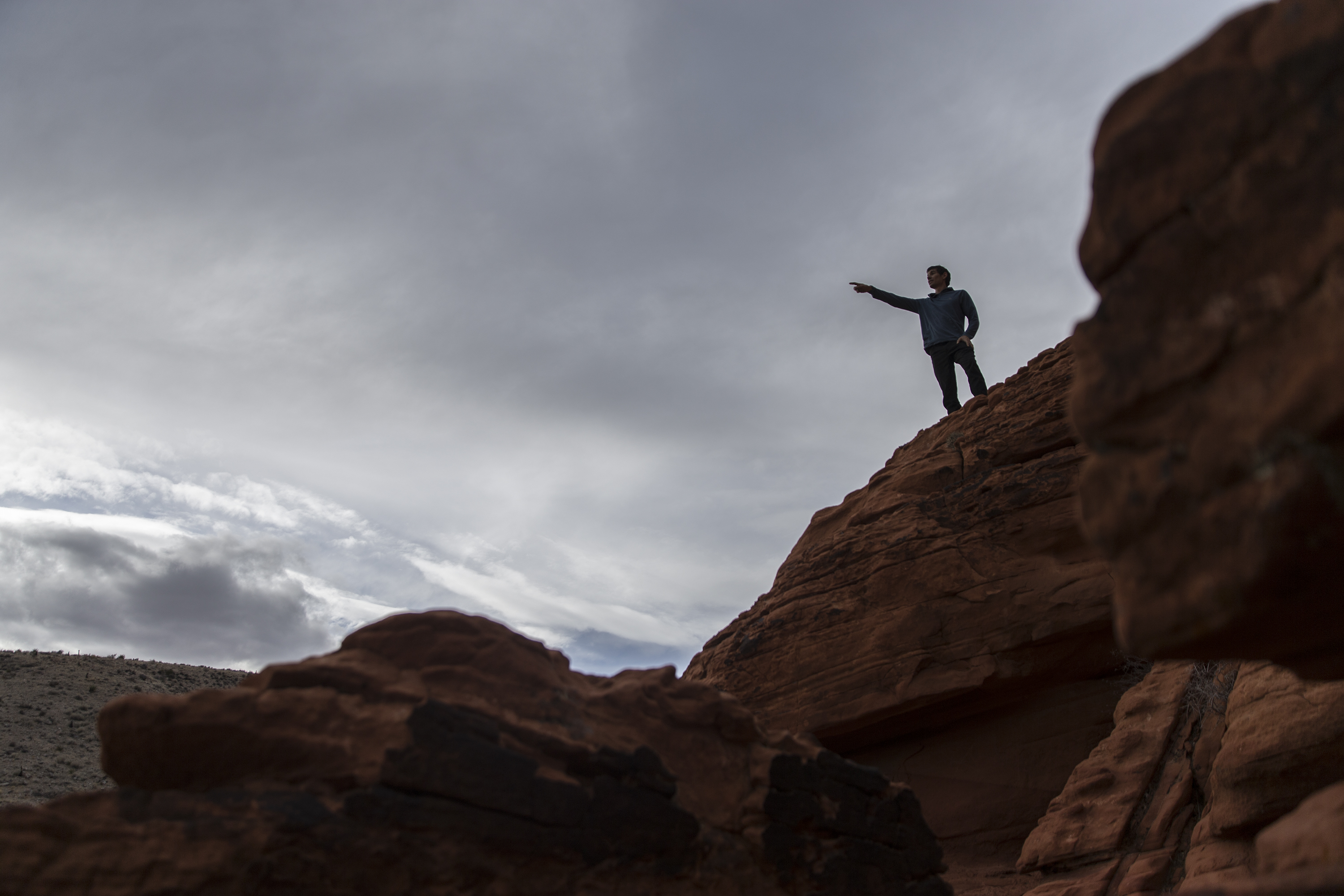
Like many locals, Honnold avoids the Strip, which feels like “another country.” Instead, he stays close to his suburban neighborhood near Summerlin that offers a distant view of Red Rock Canyon National Conservation Area, where he regularly trains.
He’s mystified why officials don’t better promote outdoor opportunities in Southern Nevada. “Rather than just gambling, why not play up the camping and outdoor recreation? It’s an incredible resource.”
People ask me all the time, especially in Europe, ‘So, why Vegas?’ And I’ll tell them, that for a rock climber, Las Vegas is like the coolest place on the planet. You can go climbing here every day of the year.
Alex Honnold, professional rock climber
Honnold and his girlfriend had previously spent the winter in Las Vegas, living out of a newer, tricked-out van, and were amazed by the sheer beauty of the sunsets. “They were spectacular,” McCandless said. “That’s one reason we fell for the place, because of all of its rock and desert beauty right on the edge of the city.”
So, Honnold bought what he calls “a classic cookie-cutter home in the suburbs” and made the slow transition from “dirt-bag” to homeowner. For weeks, before he bought furniture, he slept in the van in the driveway, slowly taking up residence between his new home’s four walls.
“The whole point of the van life was to be able to climb full time,” he said. “The beauty of Vegas is that I can take showers and cook home meals and be close to my climbing; it’s the best of both worlds.”
In fact, there are so many prime rock-climbing spots here that Honnold has yet to get to them all. “Within an hour-and-a-half’s drive, you have the best climbing in the U.S.,” he said. “There’s enough climbing here to last me a lifetime.”
‘Dorky loner’
Honnold grew up in Sacramento, one of two children born to Charles Honnold and Dierdre Wolownick, middle-class language professors at a community college.
Right off, the kid was a natural climber — furniture, counters, cupboards — and when he was 5 his mother took him to a rock-climbing gym. Five years later, his father was driving him around the state every weekend for competitions. Honnold devoured climbing magazines and watched countless videos.
At age 18, the self-described quiet “dorky loner” with big ears and a passion for books was among the nation’s top competitive gym climbers.
 Alex Honnold at The Gallery at Red Rock Canyon on Dec. 17, 2018, in Las Vegas. (Benjamin Hager / Las Vegas Review-Journal)
Alex Honnold at The Gallery at Red Rock Canyon on Dec. 17, 2018, in Las Vegas. (Benjamin Hager / Las Vegas Review-Journal)He left home to study civil engineering at the University of California, Berkeley, the same year his parents decided to split. The breakup distracted him, and he began skipping classes, instead venturing out most days to rock climb.
That summer, Honnold suffered another trauma: His father died of a heart attack. Soon afterward, he asked his mother for permission not to return to college. Follow your path, she advised.
He moved into her old minivan, using it as a base to travel the region, working on his climbing technique, getting stronger, looking for new mountains to scale. He was drawn to places with good climbing. He told his mother that if he ever settled down, it would be in Las Vegas.
In the coming years, Honnold’s career featured a steady, well-calculated rise, not unlike one of his rock ascents. He began doing free solos in 2006.
Two years later, at the age of 23, he made a rope-free climb of the 2,000-foot-tall face of Half Dome in Yosemite. That climb was documented in a 2010 short film called “Alone on the Wall,” which helped him establish a crossover reputation outside rock-climbing circles. His memoir with the same title followed several years later.
By 2014, Honnold had attracted a bevy of corporate sponsors. He had also created a nonprofit foundation to help fund solar-energy projects.
Big Stone
But a bigger challenge loomed: a first-ever free-solo ascent of El Capitan, which climbers call the world’s most-imposing wall of rock.
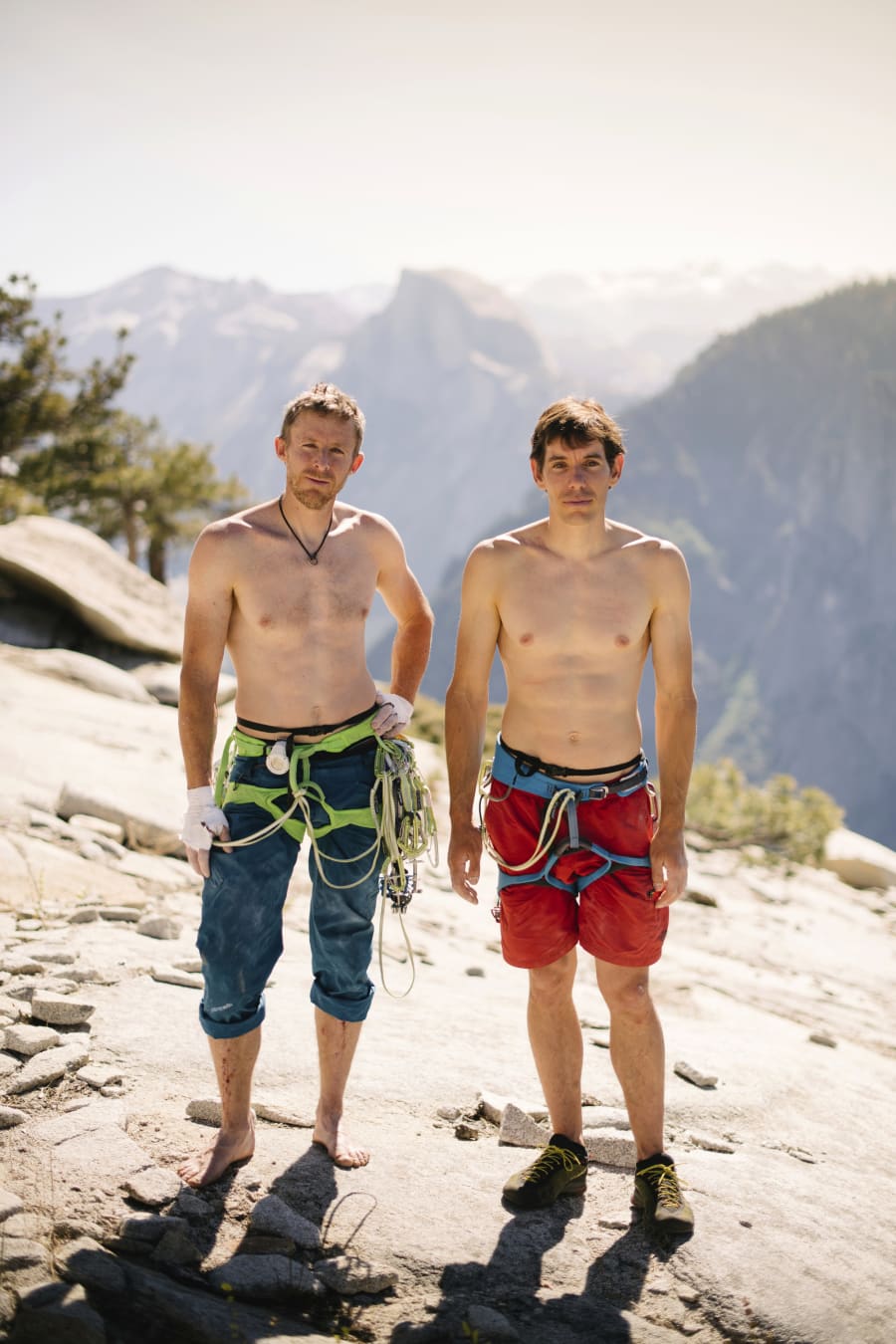
Known among pro climbers as the Big Stone, it’s a monolith of smooth, polished granite immortalized by photographer Ansel Adams and environmentalist John Muir.
Until Honnold’s climb, a free solo of El Capitan was the untouchable pinnacle of the dangerous sport. For eight years, Honnold obsessed about the climb.
“It’s impossible to overestimate the relevance of El Capitan,” he said. “Its mythology and history are awe-inspiring. For a climber, there’s this extra dimension. The place is just so important.”
Honnold is quick to stress that he’s no manic thrill-seeker, but a cautious perfectionist. Before he climbed El Capitan, he had trained for years, building strength by hanging for an hour each day from his fingertips, memorizing the complex sequences of hand and foot maneuvers required to overcome its relentless steepness and reach the top.
On the rock, Honnold said, he feels in command of his own small universe. He trusts in his talents and decision-making. By the time he completed his free solo of El Cap, he’d made so many practice runs, “it didn’t seem so crazy anymore.”
Still, he acknowledges the line of distinction between “badass” and “dumbass.” “Every climber has crossed that line,” he said, “including me.”
Fear factor
He understands why so many fans ask, “Are you afraid up there?”
He describes himself as a tiny dot on a big ocean of rock, alone on a huge, uncaring face of granite. But Honnold revels in the risk. “Everyone has experienced fear, and they’re all curious about how to deal with it,” he said.
“And I know that free-soloing looks scary. It’s the way I look at big-wave surfing, which just seems terrifying to me. Or race car drivers. Maybe they’re petrified the whole time they’re doing it.”
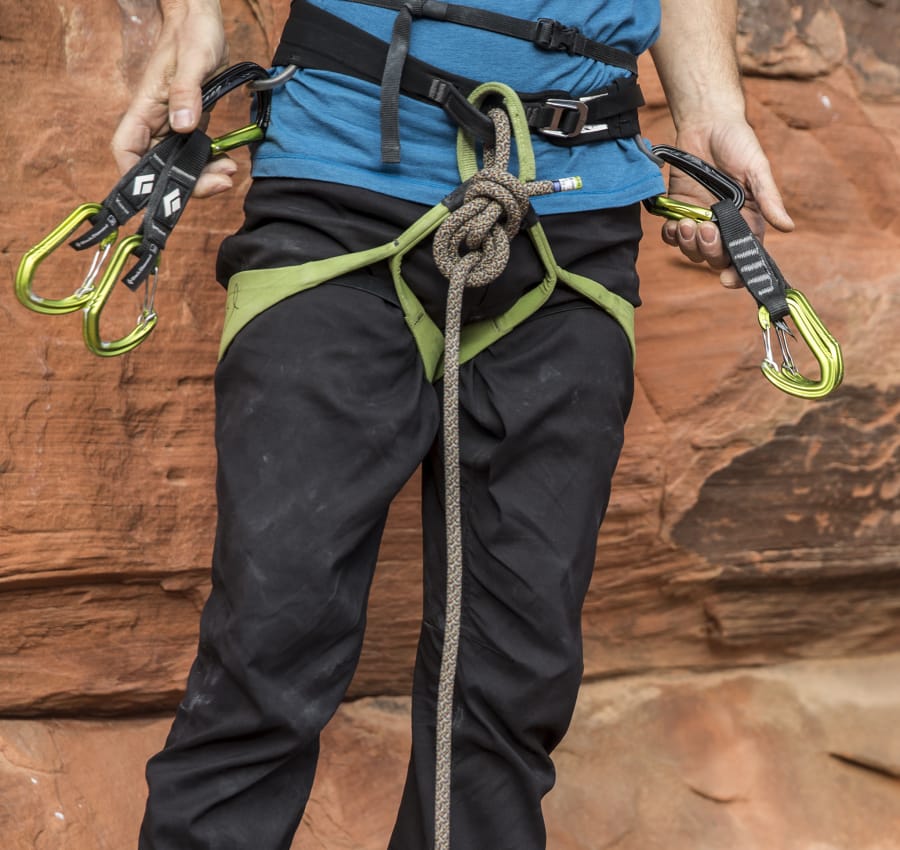
The challenge is to be in control, even in a very dangerous place, and celebrate the experience. On each climb, Honnold remains mindful of the stunning views. He listens to his breathing and the sound of the wind, and feels the soft gymnast’s chalk on his fingers and the hard rock looming in front of his face.
“I’ve been able to get to the top of every mountain I’ve climbed,” he said, “because I enjoy the ride.”
Still, Dierdre Wolownick worries that her son will one day plummet to his death. “‘Worry’ is not quite the word,” she said. “That’s a pale word, like worrying that you’ll run out of gas. This is a different animal altogether.”
'I trust his judgment’
A decade ago, Wolownick, 67, began rock climbing herself “just to see what he was doing out there.” She became the oldest woman ever to climb El Capitan when she was 66.
Wolownick’s book about raising a rock climber, titled “The Sharp End of Life: A Mother’s Story,” is set to publish this spring.
Becoming a rock climber, she said, was the only way to maintain a relationship with her now-famous son. “I realized years ago that I could either be a part of his life, or not,” she said. “And I knew that if I complained about his climbing, I would not be a part of his life.”
Now she can at least appreciate his risk-taking.
“I trust his judgment; it has to come down to that,” Wolownick said. “He’s the only one capable of knowing if he can do a climb. And no matter what I or anyone else says, he’s going to do it anyway.”
Since the release of “Free Solo” last fall, Honnold’s life has been a torrent of travel, giving interviews and attending movie premieres worldwide. “It’s been crazy,” he said. “An unsustainable crazy. I wouldn’t want it to be my life.”
But success hasn’t changed him. Now worth an estimated $2 million, he still lives frugally. He has told groups that he still makes less than the average NFL rookie, more like a “moderately successful orthodontist.”
A trip to The Gallery
On a cloudy morning in mid-December, Honnold, his girlfriend, and her two relatives drove to Red Rock Canyon for a day of climbing. They were headed for a popular wall known as The Gallery that features climbing routes such as “The Goode Dude Climb,” “Pump First, Pay Later,” “Running Amok” and “Where the Down Boys Go.”
As they pulled into the Calico Hills 2 parking area, the day threatened rain.
 Alex Honnold, left, and girlfriend Cassandra “Sanni” McCandless prepare to climb at The Gallery at Red Rock Canyon on Dec. 17, 2018, in Las Vegas. (Benjamin Hager / Las Vegas Review-Journal)
Alex Honnold, left, and girlfriend Cassandra “Sanni” McCandless prepare to climb at The Gallery at Red Rock Canyon on Dec. 17, 2018, in Las Vegas. (Benjamin Hager / Las Vegas Review-Journal)“I don’t know,” somebody said. “It’s not quite perfect.”
Later, Honnold laughed at the moment.
“I said, ‘Dude, this is like perfect.’ It might be a bad-weather day in Las Vegas, but it would be the best day of the year in the U.K.!’”
They hiked for 20 minutes toward The Gallery along a twisting, unmarked route that led them through hard-to-negotiate cracks and crevices of red rock. Honnold, his big hands hanging at his sides, picked his way along easily, like a sure-footed mountain goat.
Other climbers paused to watch him pass. Around here, everybody knows Alex Honnold. Among them was 31-year-old Brent Maxfield, who has seen “Free Solo.”
“There’s a method to Alex’s madness,” he said. “If this is what makes him happy, if he feels like he’s in control, that’s all that matters.”
Honnold also has raised public awareness of rock climbing. “It’s a thing now,” Maxfield said. “Because of him, people can say, ‘We’re climbers. We care about this rock,’ challenging developers who insist, ‘We don’t care about you, so we’re going to blow it up.’”
Several climbers approach Honnold for selfies, and he happily obliges. McCandless said she is often less patient.
“One day, I asked him, ‘Are there any days when you just say no?’”
He looked at her.
“Not really,” he replied. “For that person, it’s an important moment, and I don’t want to shut them down.”
Still, life in Las Vegas offers Honnold a bit of anonymity. Most residents here, he said, don’t rock climb, so he’s not mobbed on the street like he is in such outdoor communities as Boulder, Colorado. “I live in the suburbs of Las Vegas,” he said. “These are not my people.”
At The Gallery, a dozen people scaled the various routes. Honnold’s in his element here; he’s most happy when he’s on a climb. But he also knows all too well that danger lurks on the rugged rock face, what climbers call the “crag.”
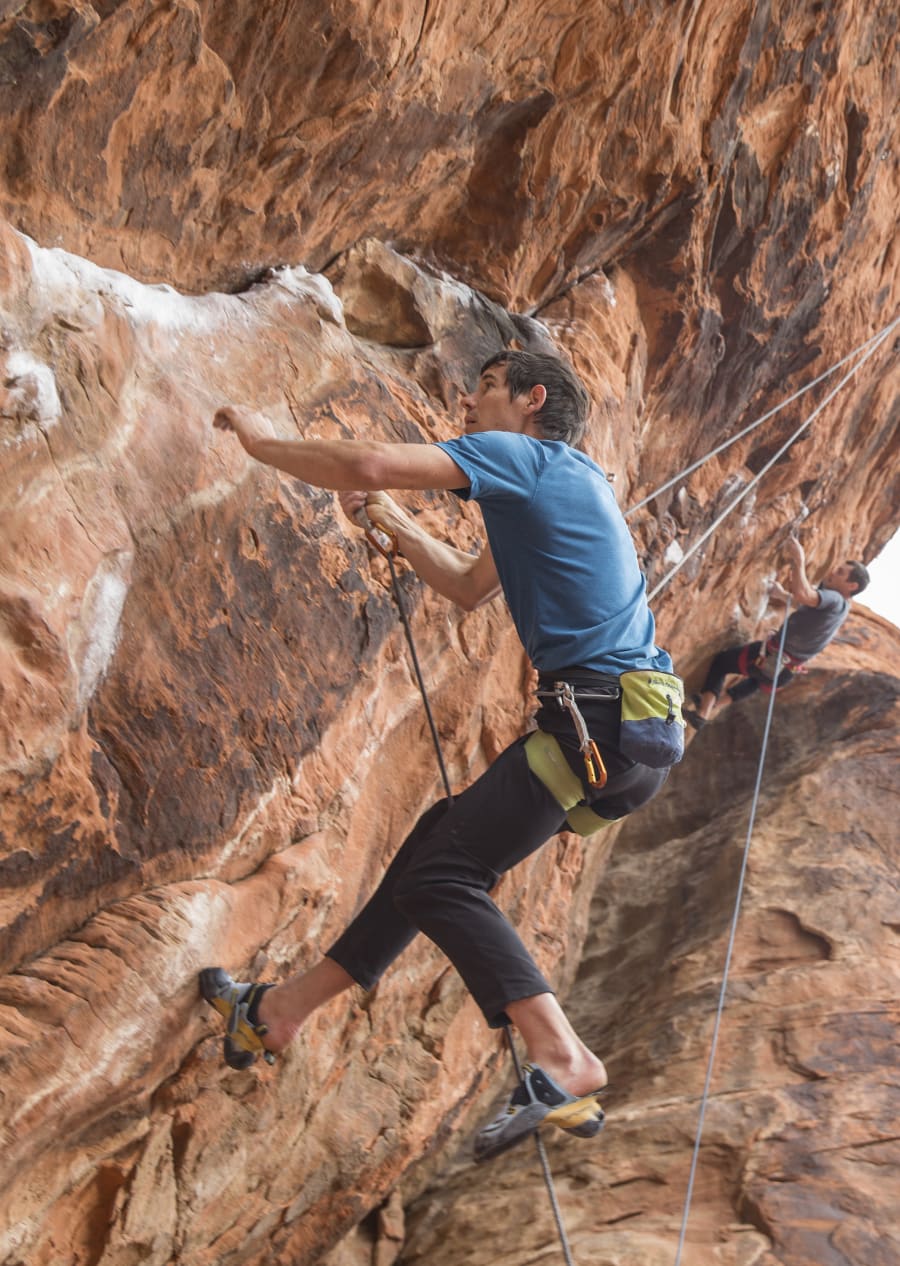
He has lost more than a dozen friends to rock-climbing falls. Last year, here at Red Rock, he was present when a climber fell to his death.
“It was pretty terrible,” he said.
Does he fear that his own time might be coming?
“Maybe. Time will tell,” he said. “I could die in a car crash on the way home today. If I do die on the mountain, I guess it wouldn’t be too much of a shock to people. But I try not to. I try to do it as safely as possible.”
For now, fans keep asking what his next great vertical adventure will be. Who knows, he said. Maybe someone will beat his free-solo time up El Capitan, tempting a return to the Big Stone.
McCandless, a life coach for athletes and outdoor enthusiasts, insists he’s not in any rush to decide.
“When Neil Armstrong came back from the moon, nobody asked him, ‘What’s next?’” she said. “I know it’s two different things, but Alex deserves time to let the dust settle, to decide in his own time what else inspires him.”
The couple performed a series of individual climbs, encouraging each other. “C’mon Alex,” McCandless said. “Breathe.”
During a break, Honnold sat with his back against a rock, biting into a red pepper like one would an apple. Rock climbing has taken him to so many beautiful places, including Europe, Asia and Antarctica. He talked of camping on an isolated ridge in Patagonia, admiring the full moon at night.
Suddenly, he went silent, gazing toward the jagged rock peaks across the valley. “Nice,” he said to no one in particular. “Really dramatic.”
Then Honnold stood up to face the rock wall and continue doing what he loves best. “OK,” he said. “I’m going up again.”
John M. Glionna, a former Los Angeles Times staff writer, may be reached at john.glionna@gmail.com.




